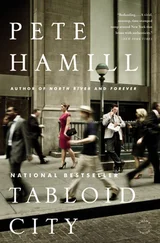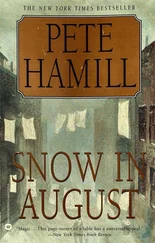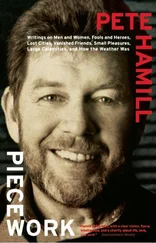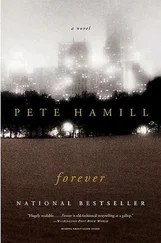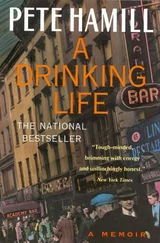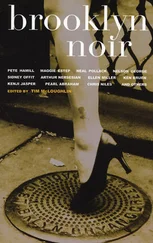There was a black sketchbook on the floor, and I looked through it, recognizing Becket and Harrelson and Boswell, and Chief McDaid and Red Cannon, all drawn very delicately with a pencil, the shading done with hundreds of tiny lines. They were not photographic likenesses; they seemed to go deeper than that, to express Becket’s good nature and Harrelson’s cruelty and Boswell’s blurry drunkenness, and the malignant core of Red and McDaid. There were also drawings of women, nude, heavy-breasted, with faces like crones, a drawing of a black man wearing a jock, his skin glistening as if he’d been oiled. A detailed study of a tree. The wreck of an old car. Ruined piers like the one in the painting. Many careful but unfinished drawings of oranges. And detailed renderings of masks. They were wonderful drawings, but they made me uneasy. Not simply because I couldn’t do them, but because of the subject matter. I’d always been the best artist in my class but I couldn’t draw like this; worse, I couldn’t imagine like this. My own drawings were usually of fights and brawls, the stuff of the comics; these were pictures you saw in museums and art books.
There were a few blank pages and then I stopped short. The next three drawings were of me. In one of them I was sitting at my desk, my back to the artist, my face in profile gazing out at the Florida day. My jaw was slack and I seemed lost in thought. In the second, I was swabbing the deck. My body was bent at a violent angle and I was wielding the huge mop as if it were a blunt instrument. The muscles of my back and arms were perfectly drawn, taut and charged with tension. The third was an unfinished portrait. Some tentative overlapping lines defined my cheekbones and jaw. The incomplete nose was gouged with erasures.
But the eyes were my eyes.
And they looked scared.
Suddenly I felt almost sick: the next day I was supposed to draw Eden Santana, but these pictures showed me that I just wasn’t good enough. If this was indeed Miles’s work, Miles should be drawing her. She deserved a better artist than I was. And I felt ashamed and envious too. Somehow, in spite of everything, in spite of all the same kind of crap that I had to put up with, Miles found a way to do his work. He even found time to draw me. He was serious . In six weeks at Ellyson, I’d made a dozen drawings in a couple of restaurants, showing off to a woman who must have seen me as an amusing amateur; certainly if Eden Santana could see Miles’s drawings, she would know how crude I truly was. I was wasting my life. I was hopelessly behind and could never catch up.
I heard footsteps out in the supply room. Someone grunted and a crate fell. I heard Boswell’s voice. “Shit. Goddamn.” Then another grunt. And then he was walking away. He and Miles were back from Mainside. I heard Harrelson’s voice in the distance, the words unclear, and a door slamming. Boswell was finished for the day.
I should have left then, but I was held by the things I saw and afraid of being spotted sneaking out of the back room. So I waited. Five minutes. Ten. Miles wasn’t coming back. I could stay a while. I felt the way I used to when I showed up early for a Mass and the priest wasn’t there and I touched all of his garments and the chalice and the Hosts, running my hands over the forbidden holy objects. Part of that was defiance; if God existed, then let Him show himself, let Him strike me dead. Part of it was awe of the beauty of the objects. I could play at being a priest. In the same mood, I picked up the tubes of paint. The label said “casein.” I opened one, sniffed it. Almost no smell. Or rather, a milky smell of some kind. Once I’d walked into the lobby of the Art Students League on 57th Street to see if they had courses in cartooning and the smell of oil and turpentine was all through the building. Casein didn’t smell like that. The tins were filled with water, so I knew it must be something you diluted.
For a moment I thought about picking up a brush and leaving a mark on the unfinished painting. Let Miles know that somewhere in the building there was another artist who knew what he was doing. Just take one little section , I thought, paint a brick into the concrete wall, make the sun begin to lift over the horizon . Then thought: No. Don’t do that. Suppose someone did that to one of your pictures? And thought: Go ahead . I picked up the largest brush and hefted it, surprised at its weight.
And then heard a door clicked shut. Silence. Then footsteps treading lightly down one of the aisles. The footsteps stopped. A grunt. A shuffling sound. And there before me, shocked and a little scared, was Miles Rayfield.
“What in the fuck are you doing here?” he said, looking angry and invaded.
“I was wondering what this was doing here,” I said, waving around the tiny studio. “I moved a crate and here it was.”
Miles didn’t budge from the narrow passageway beside the wall. His eyes glanced over the paints, pictures, easel. His voice dropped to a whisper:
“Did you tell anybody?”
“No. I replaced the crate to keep it hidden.”
“The truth. I have to know.”
“Why would I tell anybody?”
He stepped into the tiny room, seeming to fill it. He picked up a brush, tapped his thigh with it.
“I could really be in the shit if they found this,” he said. “ Deep shit.”
“Only if they find it.”
Miles sighed. “That’s inevitable. One fine morning, some asshole like Harrelson or Boswell or Jones will move a crate and it’ll be all over. They’ll arrest me. Arrest the paintings. Send me to the god-damned brig and the pictures to that fucking dumpster you’re always guarding …” He smiled in a trapped way, then looked at me. “Why didn’t you tell anybody?”
I struggled to say the words. “Well, I’m kind of an artist, too.”
Miles blinked. “We’d better take a walk.”
We walked around the base in the fading light. I tried to explain about being a cartoonist and Miles said he thought that if I had any talent at all, that was the way to waste it. I told him I was going to meet a woman the following night and make some drawings and he said he’d like to see them and asked me if she was a nude model and I said I didn’t know, she was a woman I knew and he said that was the worst kind of model, because you want to flatter them, make them pretty when they’re not. He wished there was a life class somewhere in Pensacola, so he could draw from a model again, but there wasn’t ’cause all these goddamned Baptists would raid the place, and I asked him why he didn’t have his wife come down and the two of them could live off the base and he could paint in the apartment and use her as a model and he just shook his head and said, No, that wouldn’t work.
“She’s gone to Jesus,” he said, as we headed for the mess hall. “The last thing the goddamned Christians will let you do is see their bodies.”
“If she’s your wife …”
“She’d sit there thinking of spending eternity in the depths of hell.”
He shifted then, explaining that casein was make of milk products, and you did dilute it with water. He liked the way casein covered a surface, but it was nowhere as subtle or juicy as oil, and you had to treat the boards, which were called Masonite, with a white primer called gesso. Some artists mixed the primer with a little sand to give it a rough texture; Miles preferred it smooth, using the brush to create textures. He mumbled when I asked him what his picture meant, saying he wasn’t really sure. The sailor in the room with the orange obviously thought he was in a jail, with Florida filling the room and crushing him. But he wasn’t sure who the old woman was on that country road and didn’t much care for the picture.
Читать дальше


